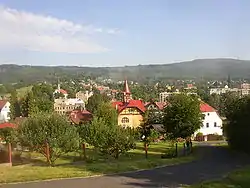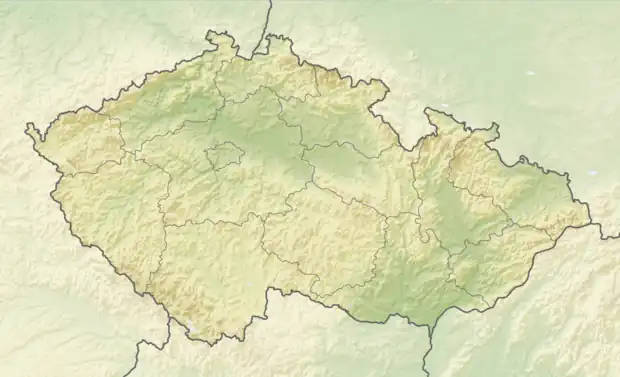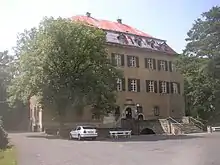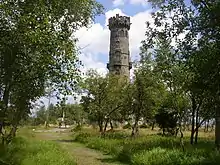Jílové
Jílové (until 1945 Jílové u Podmokel; German: Eulau) is a town in Děčín District in the Ústí nad Labem Region of the Czech Republic. It has about 5,000 inhabitants.
Jílové | |
|---|---|
 View from the south | |
 Flag  Coat of arms | |
 Jílové Location in the Czech Republic | |
| Coordinates: 50°45′45″N 14°6′18″E | |
| Country | |
| Region | Ústí nad Labem |
| District | Děčín |
| First mentioned | 1348 |
| Government | |
| • Mayor | Kateřina Sýkorová |
| Area | |
| • Total | 36.56 km2 (14.12 sq mi) |
| Elevation | 276 m (906 ft) |
| Population (2023-01-01)[1] | |
| • Total | 5,037 |
| • Density | 140/km2 (360/sq mi) |
| Time zone | UTC+1 (CET) |
| • Summer (DST) | UTC+2 (CEST) |
| Postal codes | 405 02, 407 01, 407 02 |
| Website | www |
Administrative parts
Villages of Kamenec, Kamenná, Martiněves, Modrá and Sněžník are administrative parts of Jílové.
Geography
Jílové is located about 6 kilometres (4 mi) west of Děčín and 10 kilometres (6 mi) north of Ústí nad Labem. It lies in the Elbe Sandstone Mountains and in the eponymous protected landscape area. The built-up area is situated in the valley of the Jílovský Stream, a left tributary of the Elbe River. The town is located at the foot of the Děčínský Sněžník mountain, which is the highest peak of the municipal territory at 723 m (2,372 ft) above sea level.
History

Jílové was probably founded as a settlement on an ancient trade route from Bohemia to Lusatia. The nearby Lotarův vrch mountain may already had been the site of the 1126 Battle of Chlumec between Duke Soběslav I of Bohemia and King Lothair III of Germany, whose exact location is unknown. The first written mention of Jílové (under the name Eulow) is from 1384 in a deed issued by King Charles IV.[2]
A local water castle, erected in the 14th century, was documented in 1554, when it was held by the Lords of Lípa.[2] After the 1620 Battle of White Mountain, the estates were seized by Emperor Ferdinand II and in 1629 granted to the Counts of Thun und Hohenstein.[3]
After World War II, the German population was expelled and the Thun und Hohenstein properties were confiscated by the Czechoslovak Republic. Jílové was promoted to a town in 1964.[3]
Demographics
|
|
| ||||||||||||||||||||||||||||||||||||||||||||||||||||||
| Source: Censuses[4][5] | ||||||||||||||||||||||||||||||||||||||||||||||||||||||||
Sights

The main landmark is the Jílové Castle. It was rebuilt in the second half of the 17th century on a Renaissance chateau, and the romantic-style park with a Neoclassical pavilion was established two centuries later. Nowadays the castle serves cultural and social purposes and houses a library.[2]
The Baroque Church of the Holy Trinity was built in 1682 and rebuilt in 1859 after it was damaged by a fire.[2]
Děčínský Sněžník is known for its observation tower. It is a 33 metres (108 ft) high stone tower built in 1864, one of the oldest observation towers in Bohemia.[6] The chapel on Děčínský Sněžník was built in 1909.[2]
Notable people
- Anna Perthen (1866–1957), politician
- Ernst Paul (1897–1978), German politician
References
- "Population of Municipalities – 1 January 2023". Czech Statistical Office. 2023-05-23.
- "Historie" (in Czech). Město Jílové. Retrieved 2021-07-15.
- "Jílové" (in Czech). InfoČesko. Retrieved 2023-03-09.
- "Historický lexikon obcí České republiky 1869–2011 – Okres Děčín" (in Czech). Czech Statistical Office. 2015-12-21. pp. 7–8.
- "Population Census 2021: Population by sex". Public Database. Czech Statistical Office. 2021-03-27.
- "Historie" (in Czech). Děčínský snežník. Retrieved 2021-07-15.
- "Statistik" (in German). Rosenthal-Bielatal. Retrieved 2021-07-15.